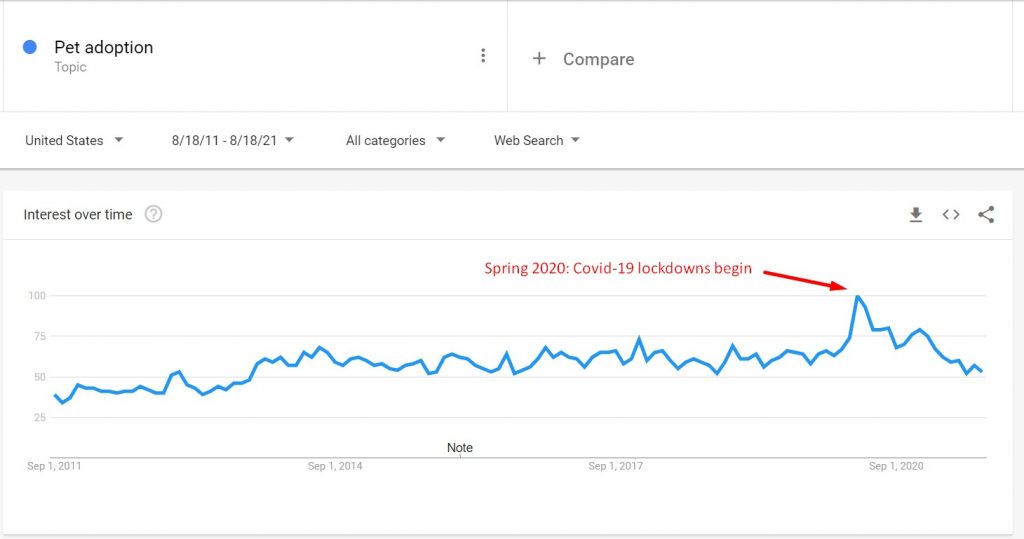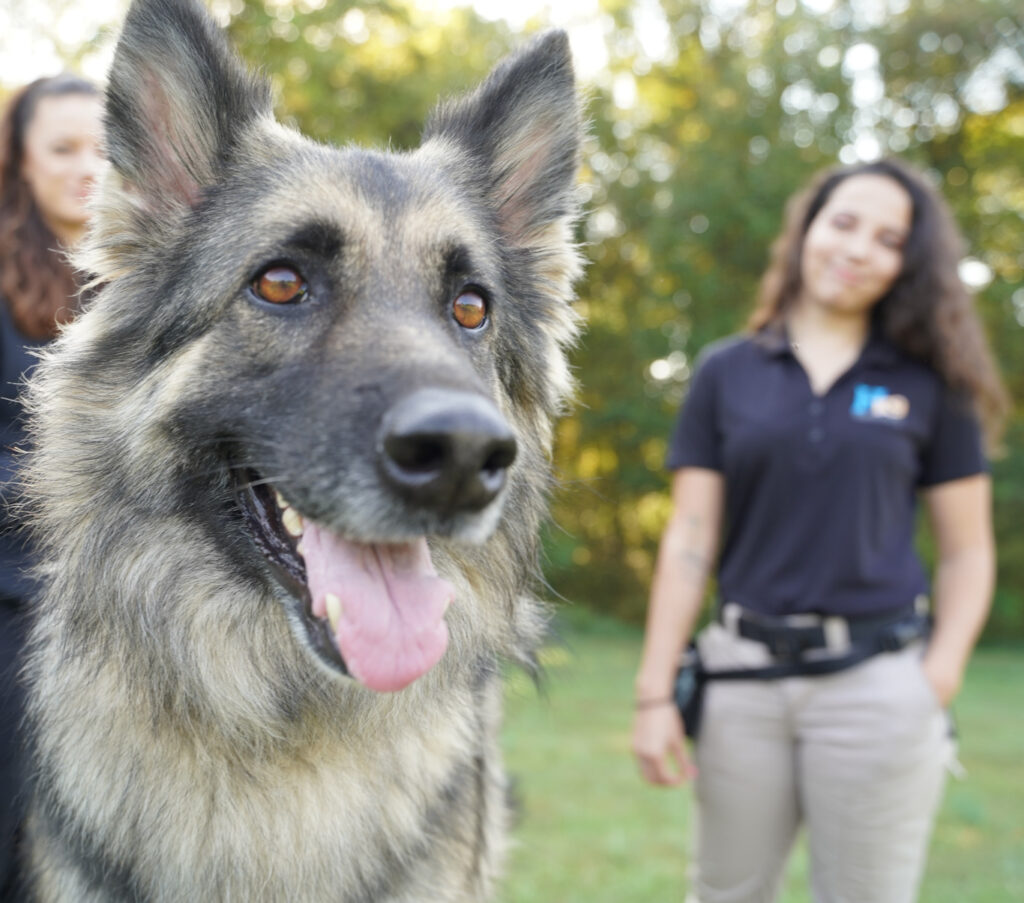In 2020, the Covid-19 pandemic led to several unexpected changes in our everyday lives. When large parts of the United States were issued with stay-at-home orders, many employees were forced to spend months working from their homes as opposed to a company office. Parents had to juggle the responsibilities of work whilst finding a way to homeschool their children. And Zoom became the default method of communication for many to stay in contact with friends or family members.
As the pandemic progresses, we have slowly seen these changes reverse and a sense of normality return. Some workers are returning to offices. Schools are able to welcome students into the classroom once again. And whilst Zoom is still an option, it is no longer the only option.
Another consequence of the pandemic was a surge in pet adoption. As families and individuals spent more time at home than ever before, many households felt this was an ideal time to acquire a puppy. According to Google Trends, online search activity around the topic of pet adoption spiked in April 2020:

Although some owners may have acted with the best of intentions when bringing their four-legged friend into their home, a new problem is now arising. As the owner’s life is returning to normal (for example, they may be outside of the home more frequently with work commitments, or planning a long overdue vacation), the biggest question now is: what happens to their ‘Covid puppy’?
Worryingly, it seems that some owners have decided to give up their pandemic pup. Some animal shelters across the nation are struggling to cope with the amount of animals being surrendered to them. In May, one Colorado rescue reported that the amount of returns has doubled what they normally deal with in an entire year. Just last month, shelters in California and New York reported seeing steep increases compared with typical surrender levels.
Perhaps you’re a first-time dog owner who simply thought that owning a dog would be easy, or maybe you have found that you just don’t have the time to work with your dog now that your life is returning to normal. If this sounds like you (or if you know someone who is struggling with their ‘lockdown puppy’), before you think about giving up your pup, we’ve assembled a few tips which could literally change your life – and the life of your dog, too.
Tip 1: Training will make your life easier
Many families who adopted puppies during Covid are first-time dog owners. Perhaps one of the hardest things for a first-time owner to deal with is the sheer amount of attention a dog requires. A dog doesn’t just enter your home and automatically understand right from wrong, and this is especially true in a dog’s formative years when they are learning how to behave and forming habits.
It is a similar process to raising a child – you have to set boundaries; remain consistent; encourage and reward them when they do what you want; and redirect and correct them when they don’t. This sounds like a simple mantra, but in reality, you may believe it is difficult if you don’t know where to start.

Irrespective of your life circumstances, help is available for you and your dog. Identifying a professional dog trainer who can understand, identify and resolve your dog’s behavioral issues is a great starting point. Usually, trainers will offer a variety of training options to suit different goals. For example, a dog who is destructive around the house would likely benefit from a series of private lessons structured around their home environment, and a leash-reactive dog will improve with lessons designed to walk the dog out in public. A knowledgeable trainer will help advise you on the best method to achieve your desired outcome.
Dog training packages can also often be tailored around your own lifestyle. If you’re heading out-of-town on vacation or for work, why not book your dog into a board and train program whilst you’re gone? Alternatively, if you spend a lot of time at home, a series of one-on-one lessons taking place on a weekly basis may be the best way forward (the trainer will usually give you a training plan to work on in-between lessons, which will help to continue your dog’s development).
Tip 2: Controlled socialization outings can benefit your dog
Many behavioral issues – particularly those involving other animals or humans – can be linked to under-socialization. Socializing your dog is a key component of their development, as it helps to teach them how to interact with the world around them.
There are a number of ways to socialize your dog. The most obvious is to take them on a regular walk – even 20-30 minutes around your sub-division will introduce them to distractions and interactions. However, there are other socialization opportunities to consider in public settings, too. Stores such as Tractor Supply, Home Depot and others are dog-friendly and will allow you to bring your pet inside. And if you’re meeting a friend at a coffee shop, why not sit outside and bring your dog along?

If you’re looking to socialize your pup with a group of other dogs in a controlled setting, a group obedience class is an affordable and sensible option. The majority of these classes are on-leash and take place under the supervision of a professional trainer who can ensure the class is safe and fun for everyone. Whilst some may suggest dog parks for socialization, the hard truth is that dog parks can be very hit-and-miss. When you take your dog to a dog park, you simply don’t know enough about other dogs and their potential issues. This can actually lead to further problems for your pup.
Socialization is so important for your dog, but it is vital to remember that your socialization outings should be positive experiences! As your confidence grows in taking your dog out in public, the more enjoyable the outings will become – for both of you.
Tip 3: Give your dog some mental stimulation
Imagine if your daily routine involved doing the exact same things in the exact same order. Day after day. Week after week. Month after month. You’d get bored, right?
Well, it’s not uncommon for dogs to get bored, too. If your dog shows signs of destructive behavior such as chewing on furniture, or barks constantly (even when there is nothing to bark at), or is generally restless and paces incessantly around your home, it is likely that they’re looking for something to do.
This is where the importance of mental stimulation becomes apparent. By making your dog think, you’re the one giving them something to do – and you are more likely to avoid those frustrating behavioral problems in the process.
There are several ways you can mentally stimulate your dog. Here are a few ideas:
- Use a puzzle toy to hide your dog’s favorite treats
- Teach them to perform a new obedience command or trick
- Enrol your dog in a specialist training class
- Change out your dog’s toys, giving them different textures and noises to interact with
- Hide their treats in places around your home and make your dog find them
- Introduce your dog to new environments or people
The list is endless. Just ask yourself what your dog’s normal routine looks like, and think about the subtle changes you could make to encourage them to think. Even something as simple as changing up your daily walk route can make a significant difference. You’ll often find that once your dog’s attention is focused on these different activities, they’ll become less destructive around your home.
Tip 4: Ensure your dog has sufficient physical activity
Common sense dictates that virtually any dog will need some level of physical exertion, but a key thing to think about here is your dog’s breed.
Some dogs – because they were bred for a certain purpose – will not only need more exercise, but they will actually enjoy different types of exercise. Look at Golden Retrievers or Labradors – these breeds were originally used to retrieve things from the water. These dogs would be prime candidates for chasing a tennis ball or pursuing a frisbee. A member of the Hound group, such as a Beagle or a Foxhound, is likely to enjoy tracking games or search and rescue activities because of its inherent sense of smell.

If you are physically active yourself and enjoy hiking, running, cycling or swimming, consider how your dog could join in with you! They would be happy to accompany you on your next hike or even run alongside you on a leisurely bike ride. These activities will not only improve your dog’s physical capabilities, but it will also provide mental stimulation by teaching them a new skill and introducing them to new sights and smells. It’s a win-win!
In conclusion
Many of the changes we have experienced throughout the Covid-19 pandemic are hopefully temporary. The majority of us hope that stay-at-home orders, masks, closed restaurants and Zoom lectures will eventually be a thing of the past.
However, it should go without saying that when you commit to bringing a new puppy into your home (pandemic or no pandemic), that is not a temporary change. On average, you are committing to looking after that dog for another 10-14 years.
If you’re an overwhelmed first-time dog owner or are starting to have second thoughts about your pandemic puppy, take a moment to reflect on the advice in this article. Following these tips can ensure a happy and fulfilling life for you and your dog!


You must be logged in to post a comment.